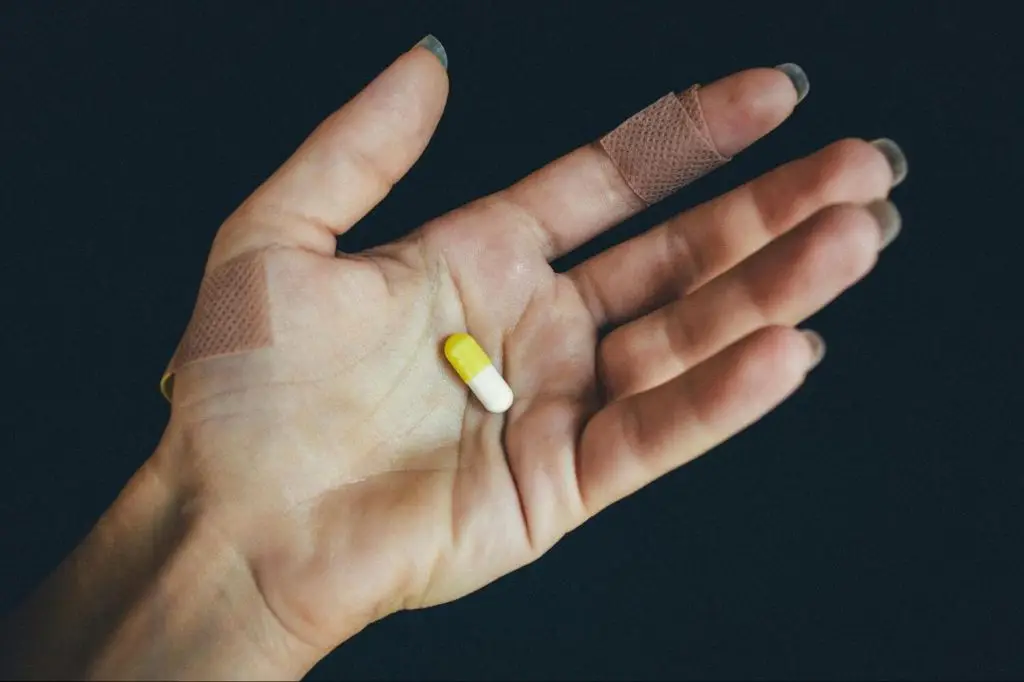The main difference between tramadol vs. Vicodin is potency. Although both medications belong to the class of opioids, Vicodin is significantly more potent than tramadol and can be used to control severe pain. Tramadol, meanwhile, is typically used for patients seeking relief from moderate to moderately severe pain.
This article will compare tramadol vs. Vicodin in greater detail to help you learn more about their differences and unique risks.
What Is Tramadol, and How Does It Work?

Tramadol is an opioid analgesic prescribed for moderate to moderately severe pain. Sold under Ultram®, ConZip®, Qdolo®, and other brands, it is available in immediate- and extended-release formulations in various forms, including capsules, tablets, and oral solutions.
Like tapentadol, tramadol is considered an atypical opioid, as it modulates the reuptake of serotonin and norepinephrine besides managing pain.
Nonetheless, it works in much the same way as other opioids: by binding to the opioid receptors in the central nervous system (CNS) and stopping pain signals from reaching the brain. Tramadol can also induce rewarding effects, such as euphoria.
While most opioid painkillers are treated as Schedule II controlled substances, tramadol falls under Schedule IV, denoting a relatively low potential for abuse and opioid dependence.
However, this doesn’t mean tramadol is not addictive—it can also lead to dependence and addiction, especially with prolonged use or misuse. In fact, it is a rather popular street drug, colloquially known as Trammies, Ultras, and Chill Pills. Taking tramadol precisely as prescribed reduces the risk of dependence, addiction, and other adverse outcomes.
What Is Vicodin, and How Does It Work?
Vicodin is a Schedule II opioid combination drug prescribed for moderate-to-severe pain management. It comes as a tablet containing two active ingredients:
- Hydrocodone, a semi-synthetic opioid pain reliever
- Acetaminophen, an over-the-counter medication used for fever and mild-to-moderate pain treatment
The hydrocodone/acetaminophen combination is currently only available as a generic drug. However, formulations containing 300 mg of acetaminophen and 2.5–10 mg of hydrocodone used to be marketed as Vicodin®, whereas those with 325 mg of acetaminophen were sold under Norco®, Lorcet®, and Lortab® brands.
Hydrocodone/acetaminophen is the most commonly prescribed opioid medication in the United States, with over 23.5 million prescriptions issued in 2022 alone. Like other prescription opioids, it alters pain perception by interacting with opioid receptors located throughout the CNS. It also triggers rewarding effects, such as euphoria and relaxation, by stimulating dopamine release.
Vicodin should be taken strictly as prescribed, as it has a high potential for abuse, dependence, and addiction. In 2022, hydrocodone products were the most frequently misused prescription pain relievers among Americans aged 12 and older. On the streets, this drug combination is known as Vikes, Watson-387, and Hydros.
Now that we’ve discussed the basics, it’s time for an in-depth comparison of tramadol vs. Vicodin.
5 Major Differences Between Tramadol vs. Vicodin

A major difference between tramadol vs. Vicodin is strength; Vicodin is considerably more potent than tramadol. Compared to morphine, tramadol is around 10 times less potent, whereas Vicodin is roughly 1.5 times more powerful.
Here’s a detailed comparison of tramadol vs. Vicodin effectiveness, chemical structure, cost, and potential for addiction and overdose:
Tramadol vs. Vicodin: Effectiveness
Tramadol and Vicodin are both highly effective in managing pain, with studies demonstrating that their effectiveness primarily depends on the type of pain they are prescribed for.
A study by researchers from The Mercy Hospital of Pittsburgh compared tramadol vs. Vicodin and determined hydrocodone/acetaminophen to be the superior option for alleviating acute musculoskeletal pain.
By contrast, Orthopedic Surgery Sports Medicine Service researchers compared tramadol with hydrocodone and oxycodone for pain relief after anterior cruciate ligament (ACL) reconstruction and arthroscopic knee debridement surgeries. The study found that tramadol provides comparable, and often even better, pain relief than the other two opioids for such pain.
Therefore, healthcare providers usually consider the type of pain patients experience when choosing between tramadol vs. Vicodin vs. Percocet for pain relief.
Tramadol vs. Vicodin: Chemical Structure
Tramadol and Vicodin differ drastically in terms of chemical structure, as tramadol is a synthetic opioid, whereas Vicodin is not.
Although tramadol structurally resembles morphine and codeine, it is fully human-made and does not contain any opium alkaloids. Unlike Vicodin, tramadol has a dual mechanism of action: besides interacting with opioid receptors, it also inhibits the reuptake of serotonin and norepinephrine. Plus, it also comes in an extended-release formulation.
Meanwhile, the opioid ingredient in Vicodin—hydrocodone—is a semi-synthetic opioid derived from thebaine or codeine. It also contains acetaminophen in its composition for enhanced pain relief.
Tramadol vs. Vicodin: Addictiveness
Tramadol and Vicodin are both addictive. However, tramadol is classified under Schedule IV, whereas Vicodin is treated as a Schedule II controlled substance. Although this indicates that Vicodin has a higher potential for abuse, dependence, and addiction, this doesn’t make tramadol safe.
A study done by Mayo Clinic researchers reveals that patients receiving tramadol face a somewhat higher risk of chronic opioid use compared to those receiving other opioids, including hydrocodone. As such, the study concludes that federal governing bodies should consider reclassifying tramadol.
Tramadol vs. Vicodin: Cost
The cost of tramadol vs. Vicodin depends on several factors, including prescription strength and the patient’s insurance coverage. Generic versions of both drugs are available and often covered by insurance.
Generic 50 mg tramadol costs around $11.76–$34.38 for a supply of 100 tablets, whereas the same quantity of 325 mg/5 mg acetaminophen/hydrocodone costs between $16.85 and $30.48. Formulations containing 300 mg of acetaminophen tend to be more expensive; the price of 300 mg/5mg acetaminophen/hydrocodone starts at $114.25 per 100 tablets.
Tramadol vs. Vicodin: Overdose
Tramadol and Vicodin can both lead to a life-threatening overdose, especially if misused. However, Vicodin is more potent than tramadol, which also makes it more dangerous.
To reduce the risk of tramadol or Vicodin overdose, always take your medication as prescribed and carefully track your opioid intake to ensure you don’t take an extra dose by accident.
Next, let’s compare tramadol vs. Vicodin side effect profiles.
Tramadol vs. Vicodin Side Effects
The side effects of tramadol and Vicodin are fairly similar, as both drugs may cause adverse effects typical of all opioids, such as:
- Fatigue
- Nausea
- Vomiting
- Dizziness
- Dry mouth
- Headache
- Drowsiness
- Constipation
Importantly, tramadol is more likely to cause serotonin syndrome than Vicodin due to its actions on serotonin-norepinephrine reuptake. While mixing this atypical opioid with other serotonergic medications, such as antidepressants, increases this risk, tramadol can also cause serotonin syndrome when taken alone, especially in high doses.
Furthermore, prolonged use and abuse of tramadol and Vicodin elevates the risk of:
- Liver, heart, and other organ damage
- Tolerance and opioid dependence
- Tramadol or Vicodin addiction
- Respiratory depression
- Fertility problems
- Opioid overdose
- Death
Importantly, some adverse effects, such as organ damage and overdose, can occur if you misuse opioid medications just once (e.g., by taking them in larger doses than prescribed or mixed with other substances).
On this note, let’s explore tramadol vs. Vicodin drug interactions.
Drug Interactions of Tramadol and Vicodin

Tramadol and Vicodin can interact with numerous drugs, including:
- Sedatives
- Other opioids
- Antipsychotics
- Antihistamines
- Muscle relaxers
- Antidepressants
- Sleep medications
This list is by no means exhaustive. Mixing opioids like tramadol and Vicodin with other drugs may increase the risk of respiratory depression, overdose, and other adverse effects. Therefore, it’s critical to inform your doctor about any medications or supplements you’re taking before initiating opioid therapy.
Furthermore, do not mix alcohol with tramadol or Vicodin; this significantly increases the risk of a potentially fatal overdose. Drinking alcohol while taking Vicodin also puts you at an increased risk of liver damage since both alcohol and acetaminophen affect the liver.
Other Risk Factors of Tramadol and Vicodin
The key risk factors that may increase the likelihood of adverse effects associated with tramadol and Vicodin include:
- Pregnancy
- Head injury
- Kidney disease
- Poor liver function
- Respiratory issues
- Cardiovascular problems
- Alcohol use disorder (AUD)
- Opioid or acetaminophen allergy
Discuss your medical history with your doctor to ensure you can safely use opioids. Tramadol may not be the right option for those with seizure disorders, as using it can trigger convulsions.
Physical Dependence and Addiction to Opioids
Physical dependence and addiction to opioids are among the greatest risks of taking tramadol and Vicodin. These drugs gradually alter brain chemistry, meaning even those who take them as prescribed can eventually become dependent.
Opioid dependence and addiction differ in that dependence refers to the physical reliance on opioids, whereas opioid addiction is largely psychological; it is marked by an uncontrollable urge to use these drugs. In other words, those dependent have to take opioids to function normally, whereas those addicted cannot help but use them, even when it harms them.
In most cases, opioid addiction develops from untreated opioid dependence. It’s in your best interest to seek professional help if you suspect you might’ve become dependent on tramadol or Vicodin.
Signs and Symptoms of Opioid Dependence
The signs and symptoms of opioid dependence include:
- Tolerance. Tramadol, Vicodin, and other opioids cause your brain to stop producing endorphins and increase the production of opioid receptors, which leads to tolerance. Because of this, opioid-dependent people have to take increasingly larger amounts of these drugs to achieve the same effects as before.
- Opioid withdrawal symptoms. Those dependent on opioids suffer from uncomfortable withdrawal symptoms upon drug cessation, including nausea, vomiting, insomnia, cravings, and depression. Because of this, abstaining from opioids can be extremely difficult; most continue taking them just to feel normal.
If you or a loved one is displaying any of these signs, know that opioid dependence and addiction can be treated.
ANR Opioid Dependence Treatment

Developed by Dr. Andre Waismann, Accelerated Neuro-Regulation (ANR) is a revolutionary treatment that heals opioid dependence within days by addressing its neurobiological causes.
ANR takes a medical approach to opioid dependence treatment by targeting its root cause: the opioid-induced chemical imbalance in the nervous system.
By re-regulating the endorphin-receptor system, this treatment restores normal brain function, eliminating withdrawal symptoms. As a result, ANR treatment negates the risk of relapse, facilitating long-lasting recovery.
Benefits of Undergoing ANR Treatment
The key benefits of undergoing ANR treatment include:
- Safety. Tailored to each patient individually and carried out by a team of board-certified healthcare professionals, ANR is very safe, even for those with co-occurring medical conditions. The procedure is only performed in an ICU setting of fully accredited hospitals with state-of-the-art medical equipment to ensure the highest patient safety standards.
- High success rate. As the only treatment that eradicates opioid dependence by addressing its root cause, ANR has achieved unparalleled success. The treatment has helped almost 25,000 people worldwide break free from opioid dependence in a matter of days.
- No opioid-replacement drugs. Unlike traditional approaches, such as medication-assisted treatment (MAT), ANR doesn’t involve Suboxone or other addictive opioid-replacement drugs. Once you complete the treatment, you can resume a normal, healthy life without opioids and cravings.
Meet Jared, who developed opioid dependence after being prescribed Vicodin following a car accident and returned to an opioid-free life with ANR:
To learn more about ANR, contact us today for a free, 100% confidential consultation.
Key Takeaways
Although tramadol is less potent than Vicodin, it can still lead to abuse, dependence, and addiction. Given that all opioids are addictive, you should only opt for tramadol or Vicodin if non-opioid medications aren’t effective enough or cannot be used.
Lastly, let’s reiterate the key points we covered today:
- The effectiveness of tramadol vs. Vicodin largely depends on the type of pain they are used to control.
- Tramadol is more likely to cause serotonin syndrome than Vicodin, even when taken on its own.
- ANR treatment is the only method that rebalances the endorphin-receptor system, making it highly effective.



